
The granite topography of Thailand’s Similan Islands gives writer and photographer Mark B Hatter plenty to work with during a journey on board the Thailand Aggressor
Words and pictures by Mark B Hatter
Occasionally, a rookie mistake can result in a positive outcome. Such was my situation on our final dive aboard the Thailand Aggressor as we approached the end of our cruise in the Andaman Sea, off the western coast of Thailand.
Everything seemed perfect on this final morning in the Similan Islands, capping off a wonderful week. The sea was smooth and super clear, and the early morning sun, hazy behind a thin layer of high clouds, would likely provide excellent sunburst photographic opportunities.
As a bonus, our boat was the only vessel at the dive site.
We’d visited Christmas Point earlier in the cruise and I was looking forward to again shooting the wildlife in and around the massive granite boulders strewn around the site.
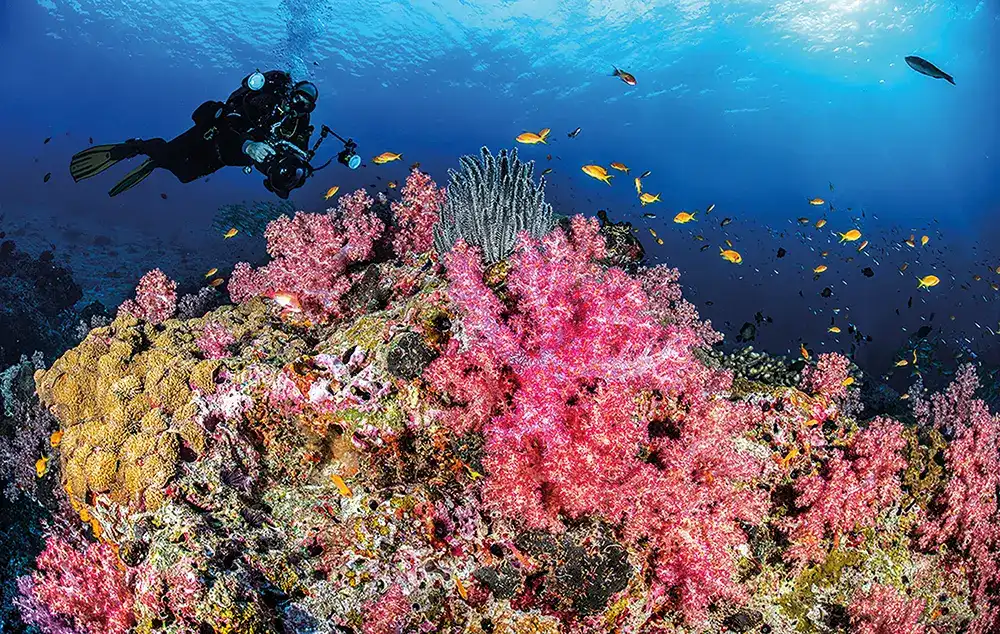
The smooth rocks are signature surface and underwater topography features of the Similan Islands. Settling onto the sandy floor at 20 metres, between two massive granite boulders, I attempted to test fire my camera to validate aperture and shutter speed settings. The lack of a response was puzzling and unsettling. Up until now, I’d had no issues with my kit.
After a quick sequence of checks, the ‘err’ message on the camera’s LCD was soberingly clear: I had left the memory card out of the camera after downloading my last series of images the night before. Something I would have realised, had I completed my gear check before climbing into the dinghy.
We’d already dived Christmas Point early in the cruise but, nevertheless, this mistake would still cost me…
Or so I thought.
THE SIMILAN ISLANDS’ GRANITE PARADISE

The Similan Islands and associated sea mounts run up the west coast of Thailand. They are mainly composed of ‘intrusive granitoids’, rocks that formed between 250 and 150 million years ago as a result of plate tectonics that allowed magma to bubble up from deep within the Earth’s core to form protrusions and small mountains.
Aeons of weathering and erosion have left the islands smoothly contoured, creating a unique topography which is extremely
popular with tourists and divers.
There are 11 ko (the Thai word for ‘island’) in the Similan Archipelago, all of which are under Thailand’s protection as a national park. While each ko has a formal name, for the sake of simplicity they are more commonly known locally as Islands 1 through to 12.
During our seven-day cruise we visited dive sites along most of them, along with those at Ko Surin and Richelieu Rock.
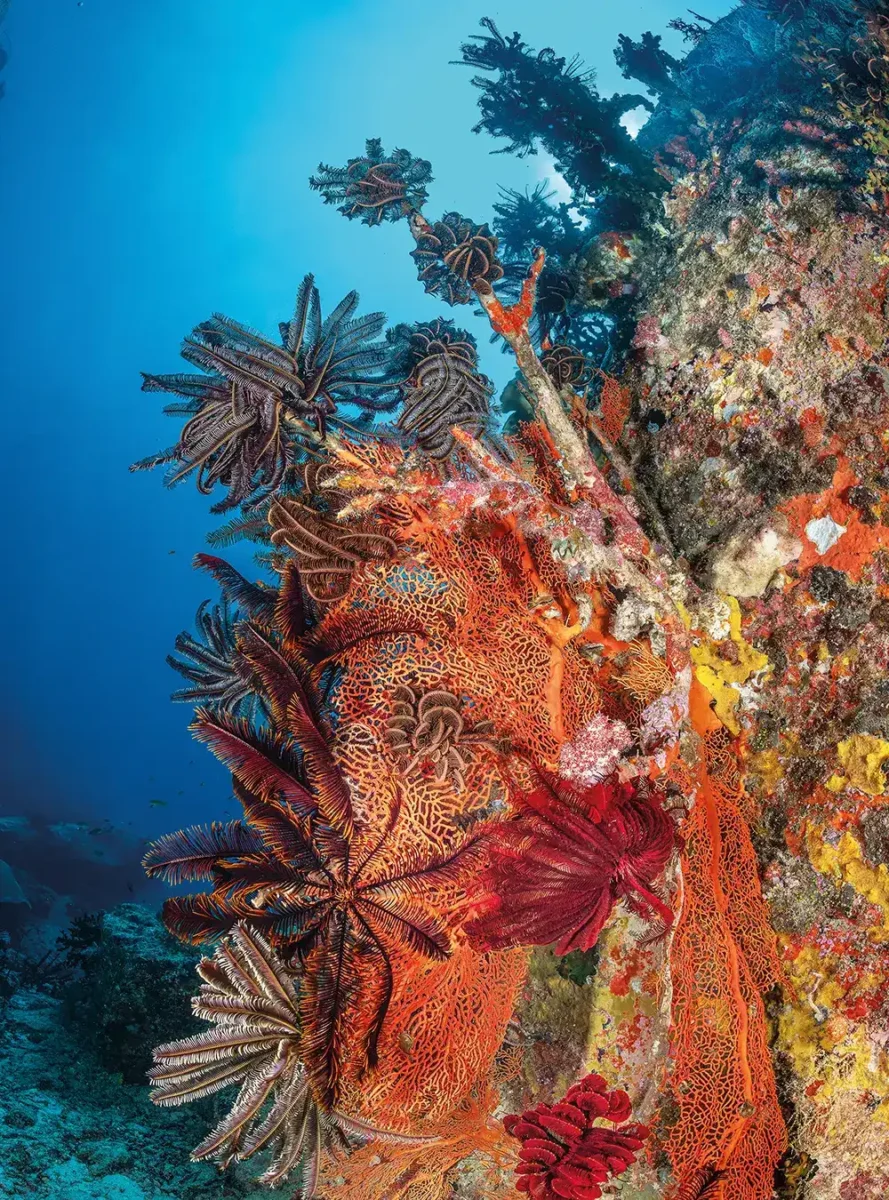
We began our journey with an introductory dive at a shallow site called Anita’s Reef, between Islands 5 and 6, where classic coral bommies rise up from a shallow sandy plain.
The morning light was perfect for capturing colourful anthias and damselfish streaming over stony coral formations. I love shooting into the sun when it’s low on the horizon, and the conditions at Anita’s were ideal that day for cool sunbursts as backdrops against bommies that were teaming with life.
Our next dive, at Elephant Head Rock, between Islands 6 and 7, was a surprisingly different experience. This site, dominated by massive granite boulders, offers classic Similan diving. You might expect the boulders to be festooned with corals and sea fans – but actually most of the rocky surfaces are oddly devoid of encrusting life. Yet there are areas on every reef that offer an exception to the rule.
At these underwater oases, soft and stony corals, as well as massive sea fans, abound. This phenomenon of largely naked rock surface is apparently completely natural and not related to climate change or historical storm impacts – indeed, there are old growth tabling corals on the smooth granite, albeit few and far between.
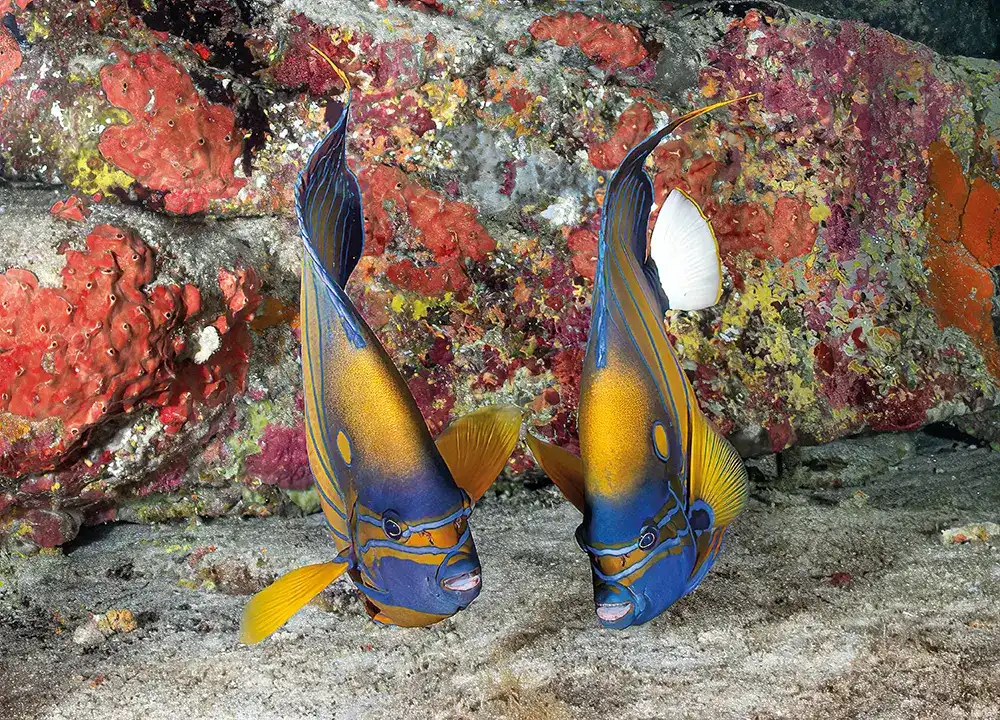
Could it be that the windward facing sides of the islands, being more exposed seasonally, are less inclined to promote extensive coral or sea fan encrusting?
We also dived a number of sites which appeared to be within the seasonal lee of an island, and provide the conditions for much more typical massive coral bommies and linear reef structures to form.
At Ko Bon (Island 10), we got the best of both worlds. Having entered the water along a windward point, we let the current sweep us past the mostly barren rocky slopes, around a boulder-strewn point, to a protected lee-side shore where we found an astonishing developed coral reef.
Almost immediately, we encountered an enormous school of batfish hovering in the current, mid-water, which captivated half of our dive group.
I was drawn instead to shoot the massive shoals of golden and translucent sweepers, ever shape-shifting, like a single amorphous organism, in and around the stony coral structures.

MEETING THE ANDAMAN LOCALS
On the afternoon of our fifth day we left the Similan Islands for the five Surin Islands, an archipelago closer to the coast of Thailand but still within the Andaman Sea.
At Ko Surin Tai we made an afternoon sojourn to a village of Indigenous sea people called the Moken, a group also known as Sea Gypsies.
The Moken number in the hundreds, share everything communally and have their own language. As people of the sea, their mode of transportation is a longboat made of hardwood, colourfully painted and propelled by the most unusual engine I’ve ever seen, bearing a drive shaft at least 3m long that terminated in a double-bladed propeller.
After our visit to the Moken village we suited up for a sunset dive along the south shore of Surin Island. In the gloaming, my dive buddy and I were blown away by the underwater metropolis of stony coral, starting near the surface and sloping to around 20m.
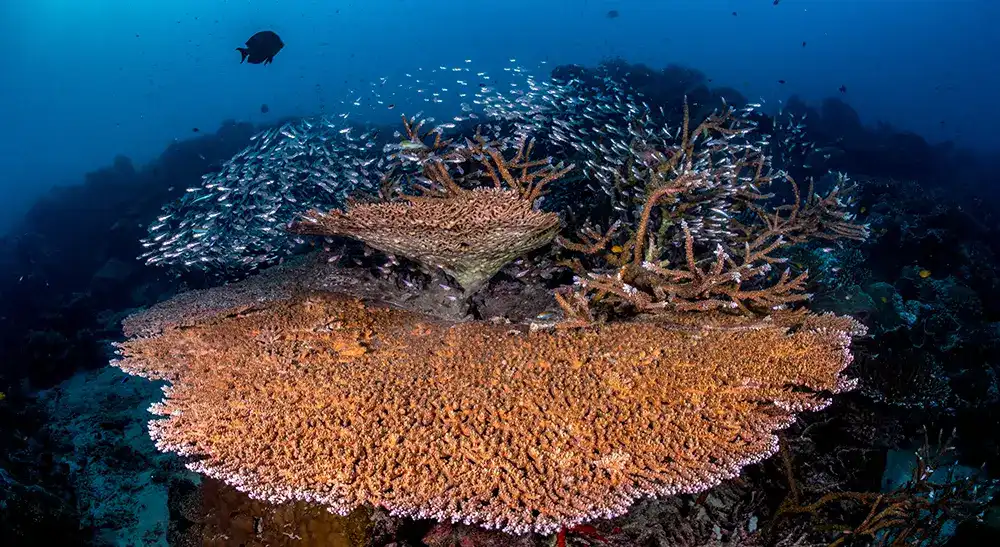
The diversity was staggering and the coral was in surprisingly excellent health. Massive tabling corals, easily 2.5m in diameter, were complemented by forests of branching staghorn corals, lettuce corals and many other species of smaller plating corals.
Between the thickets of coral, an occasional magnificent anemone, replete with anemonefish, punctuated the dense seascape.
The dive was incredibl,e and it was only our inability to focus on subjects after twilight that ultimately drove us from the water. The surprising old-growth fringe reef at the south end of Surin Island left me perplexed about how this magnificent feat of nature could be evading the ever-encroaching threat of climate change.
Happily, at least for now, there are still places on the planet that are defying the odds of human-caused degradation.
DIVING RICHELIEU ROCK
The following morning we travelled before dawn to reach one of six mooring buoys off fabled Richelieu Rock, a massive underwater pinnacle barely reaching the surface between the Similan and Surin islands.
‘The Rock’ is one of the most popular dive sites on the planet, visited daily by dozens of boats and hundreds of divers – and for good reason.
As an isolated pinnacle in the open ocean, the Rock is swept by unimpeded currents that support an astounding abundance of life. Signature species include a myriad pastel-coloured carnation corals, giant sea fans and more magnificent anemones than I’ve ever seen in one place.
When the current is raging at Richelieu Rock, it’s the side receiving the brunt of the current where everything happens.
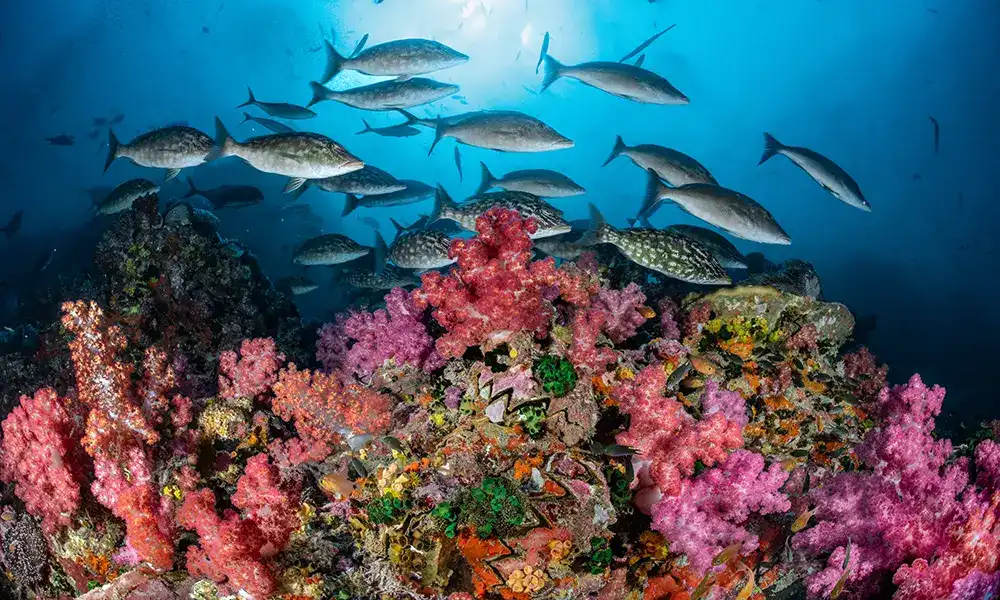
Shoals of glass fish are under continuous assault from schools of predator jackfish, long-nose emperor fish, groupers and snappers. Carnation corals covering every available surface swell in the tidal flow.
At the crown of the pinnacle, anemonefish in thousands of magnificent anemones fight to keep from being swept away from their hosts.
We make the penultimate dive of our trip at the Rock as the sun is going down. The day boats are gone and divers from the few other liveaboards still moored on fixed buoys have all left the water.
We have the place to ourselves in the waning light. Magnificent anemones often fold up into the shape of an onion at twilight. Seeing this phenomenon, with thousands of anemones in action at once, left me shooting continuously until it was time to go topside.
A NEW PERSPECTIVE
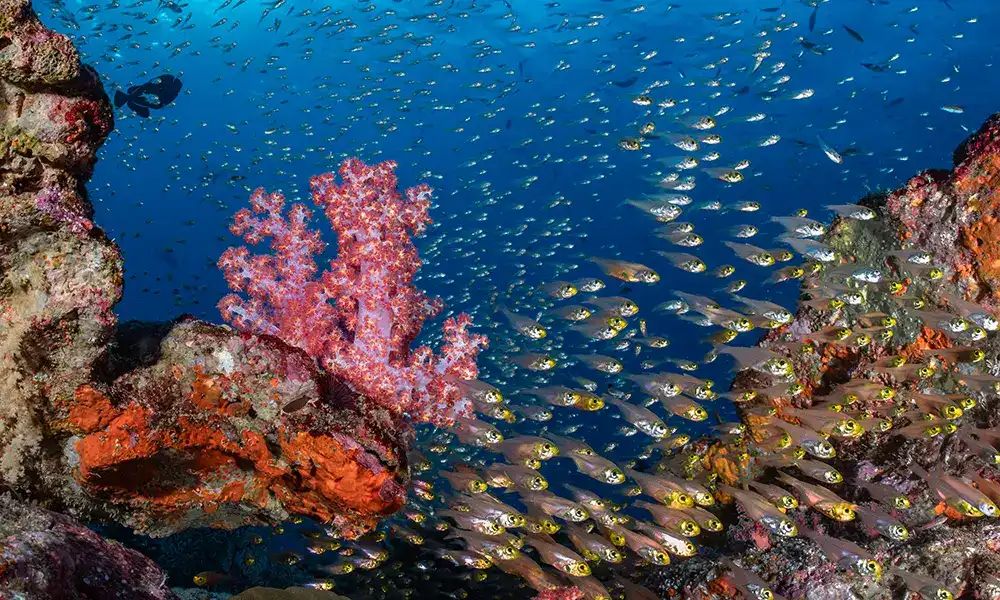
I had a lot of images to process after four dives at Richelieu, which might explain why I had forgotten to put my memory card back in the camera immediately after completing the download.
Thus it was that I found myself at Christmas Point completing my last dive yet unable to shoot any more. Rather than regretting my foolish error, though, I was ultimately glad of it.
I’d been shooting Similan’s granite-based reefs for the better part of a week, and it was only on that final dive, without the burden of searching for viable scenes to photograph, that my eyes and mind were opened to the surprising, spectacular underwater vista that is Thailand’s Andaman Sea
THAILAND AGGRESSOR
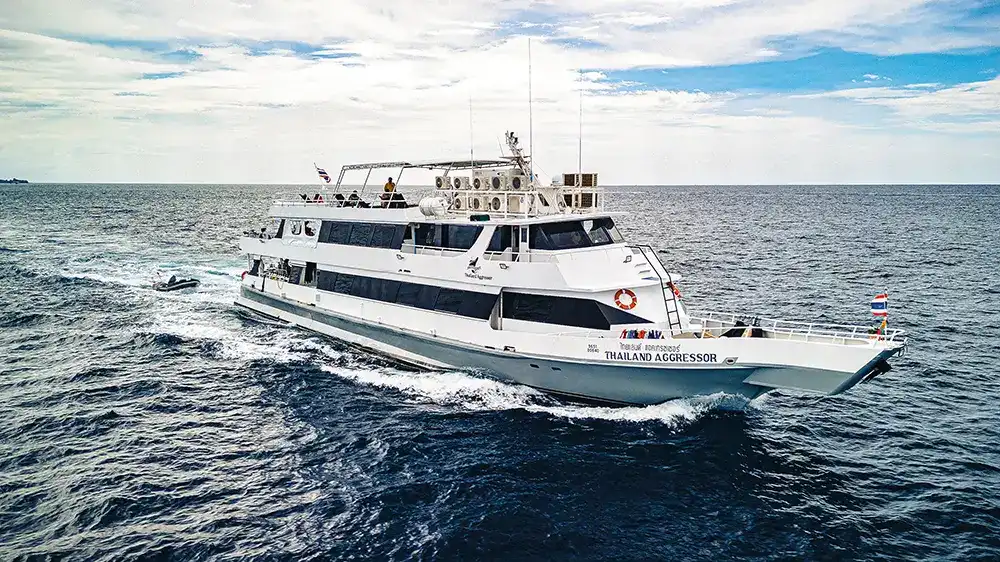
The Thailand Aggressor was recommissioned in October 2024, so facilities are excellent. Meals include Thai lunches and dinners, and western breakfasts.
The vessel offers two routes, season-dependent. I selected the North Andaman Sea voyage, which covers dive sites in the Similan Islands, Surin Islands and Richelieu Rock, and departs from Tap Lamu Pier, 60-90 minutes by road from Phuket International Airport.
The divemasters and cruise director gave wide latitude on every dive, something photographers will appreciate. As long as we were paired with a buddy and carried an SMB, we were free to dive each site as we liked.
We were offered five dives per day on three occasions.
For more information, visit www.aggressor.com
More great reads from our magazine
- Painting with Light – an interview with Catherine Holmes
- Artificial Intelligence – good or bad for underwater photography?
- Liveaboard safety – how divers can change it and when to walk away
- Luxury resort versus budget homestay in Raja Ampat
- The National Lobster Hatchery – giving lobsters a helping hand



